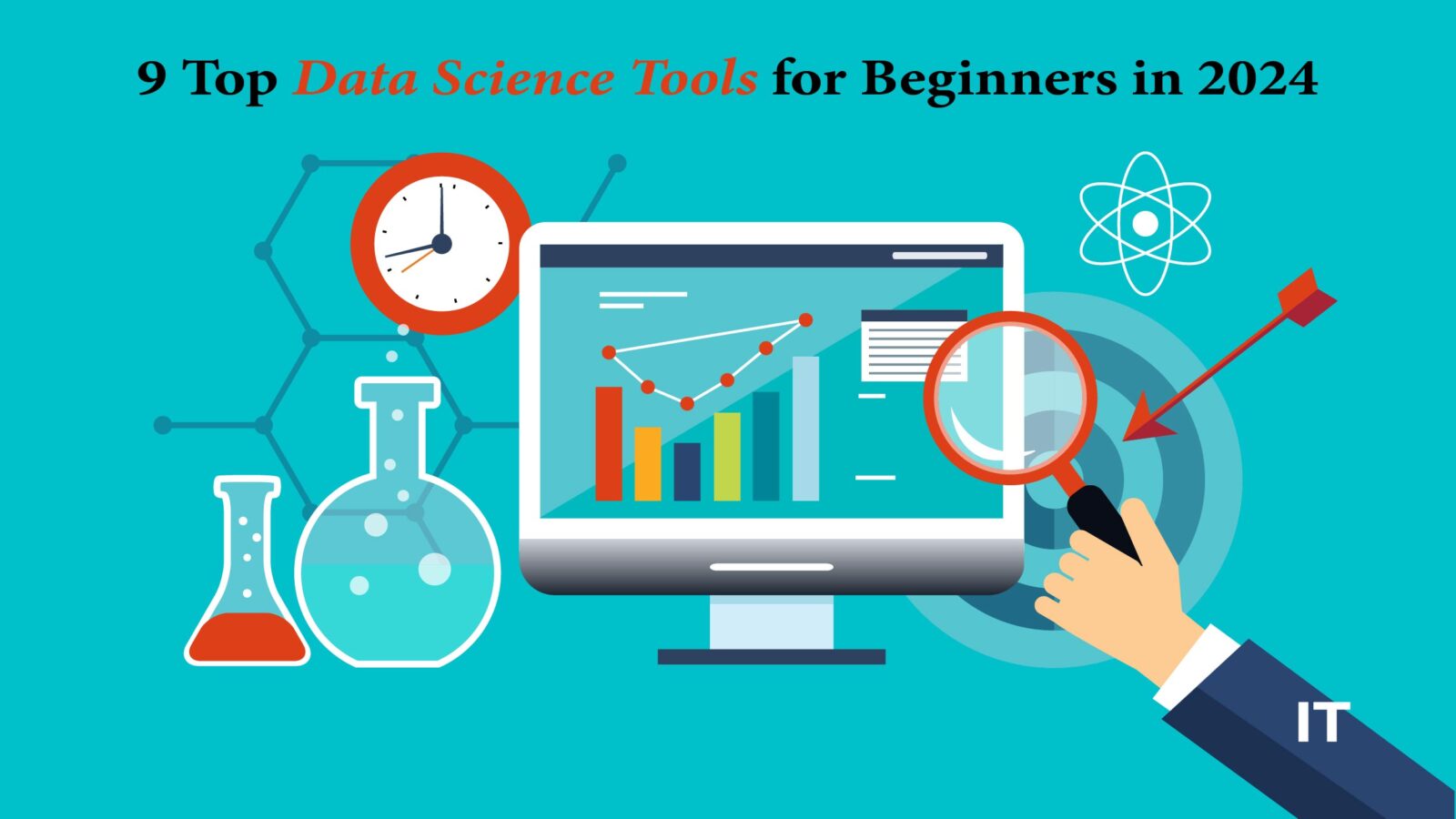Manual data processing and the analysis of raw data could be tiresome. Businesses need faster, more precise, and comprehensive solutions that can help them cut through the clutter.
This is where data science tools come in handy.
According to recent research by consulting firm Wavestone, allocating resources to data and analytics is still a key strategic focus, as stated by 87.9% of chief data officers and other senior IT and business executives in 102 top firms. This article lists the data science tools and techniques you should consider using and why they’re important.
What Are Data Science Tools?
Data science tools are software programs or frameworks that help data scientists perform different tasks, including data analysis, reporting, cleansing, visualization, mining, and filtering. These tools offer a variety of features that help data scientists draw insightful conclusions from data and make educated choices.
Why Are Data Science Tools Important For Data Analysis?
 Here are several compelling reasons why data science tools are indispensable for effective data analysis:
Here are several compelling reasons why data science tools are indispensable for effective data analysis:
- Automate Tasks: These tools automate repetitive tasks. streamline workflows and enhance data processing efficiency, empowering data scientists to effectively manage extensive and intricate datasets, thereby optimizing time and effort in the data analysis process.
- Advanced Analytics: Data analysis tools furnish an extensive selection of analytical techniques and algorithms that transcend basic statistical analysis. These tools empower data scientists to conduct intricate tasks such as predictive modeling, machine learning, natural language processing, and data visualization.
- Data Cleansing: When it comes to data analysis, you often encounter messy and unstructured data that needs sorting out before diving into the insights. These tools offer features to clean, transform, and prepare data, making sure it’s ready for analysis.
Also Read: What is Big Data Architecture? A Comprehensive Guide
- Data Visualization: This feature is indispensable in unraveling patterns, trends, and relationships ingrained within datasets. These tools help in crafting engaging and elucidative visual displays of datasets.
- Collaboration: It fosters a collaborative setting, enabling teams to engage in exchange discoveries and partake in project cooperation. These tools support the dissemination of knowledge and ensure version control and reproducibility of analyses, thus enriching the collaboration landscape for data scientists.
- Scalability and Performance: These efficiently tackle extensive data analysis tasks. They use parallel processing, distributed computing, and optimized algorithms to ensure scalability and performance, allowing data scientists to analyze massive datasets seamlessly.
- Tailoring: They offer a wide range of possibilities, granting practitioners the liberty to handpick solutions tailored precisely to their workflow, akin to a tailor customizing a suit to fit perfectly.
9 Top Data Science Tools to Use in 2024
 MS Excel (General-purpose tools)
MS Excel (General-purpose tools)
Everyone must have a fundamental understanding of MS Excel, the indispensable tool for data analysis. Freshmen greatly benefit from leveraging this tool for data interpretation. A part of the MS Office suite, MS Excel, offers both newcomers and seasoned professionals an initial grasp of data insights before delving into advanced analytics. It aids in quickly grasping data with its built-in formulas and a range of data visualization elements, such as charts and graphs. Through MS Excel data science, professionals can simplify data representation using rows and columns, ensuring even non-technical users can easily comprehend the data.
BigML (Cloud-based tools)
BigML functions as an online cloud-based, event-driven tool tailored to support a wide array of data science and machine-learning tasks. Featuring a user-friendly graphical user interface, this platform empowers newcomers to effortlessly create models through drag-and-drop functionalities. Professionals and businesses alike find BigML indispensable for integrating data science and machine learning seamlessly into diverse business operations. Companies across various sectors rely on BigML for tasks such as risk assessment, threat analysis, and weather forecasting. The integration of REST APIs ensures user-friendly web interfaces. Additionally, users can capitalize on its capabilities to produce interactive data visualizations paired with an extensive range of automation techniques aimed at simplifying manual data workflows.
Google Analytics
Google Analytics, often abbreviated as GA, serves as a sophisticated data science tool and framework tailored to provide a thorough insight into the performance of an enterprise website or app, enabling data-driven insights. Designed to support digital marketing endeavors, this data science tool facilitates easy-access visualization and analysis of website traffic and other essential data through Google Analytics. By shedding light on user interactions with websites, this tool equips businesses with invaluable insights. Google Analytics seamlessly integrates with products like Search Console, Google Ads, and Data Studio, making it a popular choice for users leveraging a variety of Google offerings. Leveraging Google Analytics allows data scientists and marketing leaders to make informed decisions with strategic implications. Its user-friendly interface and advanced functionalities even make it accessible for non-technical data science professionals to efficiently conduct data analytics.
Apache Spark (Versatile Tools for Data Analysis)
Apache Spark emerges as a prominent player in the data science field, known for its multifaceted presence as a tool framework and library. Sporting a robust analytics engine capable of handling both stream processing and batch processing, it excels in real-time data analysis and proficient cluster management, setting it apart from counterparts like Hadoop in terms of speed. Beyond data analysis, Apache Spark extends its utility to machine learning endeavors, hosting an array of built-in machine learning APIs that empower machine learning professionals and data scientists to craft predictive models. Furthermore, Apache Spark provides a range of APIs customized for Python, Java, and Scala developers to easily integrate into their programming projects.
Matlab
Matlab shines as a proprietary haven of digital mastery, exuding unparalleled numerical supremacy and simulation prowess. In the grand tapestry of data science, this masterpiece reigns supreme, orchestrating matrix wizardry, algorithmic brilliance, and statistical artistry with mathematical finesse. By seamlessly integrating visualization, computation, analysis, and programming, Matlab weaves a symphony of data magic, enchanting enthusiasts in the realms of signal manipulation, image wizardry, and neural network sorcery.
SAS
SAS aka statistical analysis system offers a treasure trove of functionalities. From advanced analysis to business intelligence and predictive analytics, this exclusive software serves up futuristic insights. Data from database files, online databases, SAS tables, and Microsoft Excel tables may all be easily accessed with the use of this program. Through the usage of its statistical libraries and tools, it is also utilized for modifying pre-existing data sets to obtain data-driven insights.
KNIME
KNIME stands out as a widely used open-source tool that facilitates tasks in data reporting, analysis, data preprocessing, and mining. Data science professionals can efficiently extract and transform data using this tool while incorporating different components for machine learning and data mining, all by leveraging its modular data pipelining concept. KNIME boasts a user-friendly graphical interface, allowing professionals to effortlessly define workflows among various predefined nodes. As a result, minimal programming expertise is required by data science professionals for data-driven analysis and operations. The visual data pipelines provided by KNIME are instrumental in rendering interactive visuals tailored to the data set at hand.
Apache Flink
Apache Flink emerges as a key player in Apache’s suite of data science tools, excelling in real-time data analysis within the open-source community. Flink, a distributed stream processing engine, enables professionals to tackle a wide range of data science tasks. From analyzing user web activities to monitoring IoT data streams and processing financial transactions, Flink offers parallel and pipelined data flow execution with minimal latency. This tool effectively handles unbounded data streams and bound datasets, ensuring high-speed processing and analysis and simplifying the complexity of real-time data operations.
Python (Programming Language-Driven Tools)
Python emerges as the frontrunner in the domain of data science programming, offering a multitude of possibilities to professionals in the field. Not just a mere data science tool, Python serves as a reliable companion, empowering professionals to effortlessly explore extensive and varied datasets. Whether grappling with structured, semistructured, or unstructured data, Python’s dynamic, high-level nature, paired with its inherent data structure and rich library array, simplifies core tasks like data analysis, cleaning, and visualization. With a simple syntax that facilitates quick learning, Python also cuts down on the costs associated with maintaining data science programs. Embraced for its versatility in developing mobile desktop and web applications, Python attracts learners eager to harness the combined strengths of data science and software development.
End Note
Data science tools are indispensable for modern data analysis and play a pivotal role in unlocking the value hidden within vast and complex datasets. By providing efficient workflows, advanced analytics capabilities, data cleansing and preparation functionalities, powerful visualization tools, collaborative environments, scalability, and customization options, these tools empower data scientists to uncover valuable insights and make informed decisions.

































